The Transcaucasus Military District can be a very useful theater for the Soviet commander who skillfully exploits its assets. Foremost, of course, are the two resource points per turn generated at Baku. These can be expended immediately for rail capacity increases, or they can be strategically railed to any point on the map for future use. For use in the southern theater, they can. be airlifted to conserve rail capacity.
If the Axis commander chooses not to fly naval-air patrol to blockade Odessa on the Jun II 1941 turn, use the Black Sea Fleet to transport the armor, the AA, and two artillery units (as well as the 5-6 rifle division at Taganrog) from Batumi or Poti to the port. If naval-air patrol is flown and a powerful force survives your fighter intercept, better to not risk the fleet and ground units trying to run the blockade. Debark instead at Sevastopol and administrative move to the front, leaving the ships well protected by AA fire in the port. The remaining available units can be sea- lifted to the front in July.
The winterized divisions should remain in the garrison to be available for the winter counteroffensive, as should the cavalry divisions since they cost too much rail capacity to move. Your initial garrisons should be the four border regiments and two cavalry divisions for the 10-RE Iran garrison; and seven mountain, one mountain cavalry, and three infantry divisions, plus two 2-6 artillery brigades on the Turkish border.
Place one of the North Caucasus MD cavalry divisions received Jul I in Ordzhonikidze and admin move it south to the Turkish border; retain the 3-8 cavalry division received in the Transcaucasus MD the same turn. Repeat the procedure during Jul II, and rail in the 3-2-8 mountain cavalry division from the Central Asia MD. This will provide a Turkish border garrison of seven mountain, two mountaincavalry, and three cavalry divisions, allowing the other units to rail/ship to the front with a minimum of rail cap expended.
Swap one of the Turkish garrison 3-8 cavalry divisions for the 3-2-8 in the Iran garrison during July. The August 3-8 cavalry division reinforcement will allow 3 border-guard regiments to disband, leaving the Iran garrison as three cavalry divisions and one border-guard regiment.
The six 3-6 rifle divisions appearing in the MD on Oct I 41 turn, plus that turn's Transcaucasus MD replacements, will allow the seven winterized divisions to rail to weather zone B for the winter counteroffensive. This will- leave the three mountain cavalry divisions in the Turkish garrison.
Until Jul I 1944, mountain divisions which are lost can never be replaced. Since these units may be needed later in either the Caucasus or the Carpathians, depending on how the war goes, they should be preserved through the winter as far as possible (that is, spread them around and have other units available to take any required losses due to exchanges).
Surviving units should be sent back to the Transcaucasus MD when mud arrives in the spring, releasing the 3-6 rifle divisions that took their place earlier for the main front (which will then be useful for converting to 4-6 rifle divisions). This does not have to done at once, but can be worked in as rail capacity becomes available.
To economize on rail capacity, ship the mountain divisions down the Volga to Astrakhan on river flotillas, then use the Caspian Sea transports to get them to Baku, where they can admin move to the border. This approach takes time and patience, but one or two divisions should not be missed at the front for a few turns. Besides, you will finally get to use your Caspian Sea fleet!
East Front Game Aids
The following two pages contain a variety of charts and records that I've found useful during play. Feel free to photocopy them for your personal use. When using them, I suggest using pencil since some of the record-keeping charted here will change over the course of the game.
The Weather Record
You will want one copy of the Weather Record for each game year. The primary value of this record is to chart your weather die-rolls during the game. Not only will you be able to back up your claims of bad luck after the game, but you will be better able to keep track of useful information like the number of consecutive cold-weather turns for freezing/thawing purposes.
The Victory-Point Cities Record
The Victory-Point Cities Record is for keeping track of the current (as well as overall) victory-point situation. Multi- hex cities have multiple entries (as many as there are hexes that comprise the city) that can be circled, crossed out, etc., as needed.
The Miscellaneous City Use Record
In addition to the notes at the bottom of the Miscellaneous City Use Record, the same data-presentation method (multiple entries for hexes of multi-hex cities) has been used as for the Victory-Point Cities Record.


More East Front
- Chapter 1: Advice for Soviet Players
Chapter 2: The Defense of Odessa
Chapter 3: The VVS
Chapter 4: The Transcaucasus Military District
Chapter 5: The Soviet "Other Forces"
Chapter 6: The Soviet Border Armies
Back to Europa Number 27 Table of Contents
Back to Europa List of Issues
Back to MagWeb Master Magazine List
© Copyright 1992 by GR/D
This article appears in MagWeb.com (Magazine Web) on the Internet World Wide Web. Other articles from military history and related magazines are available at http://www.magweb.com